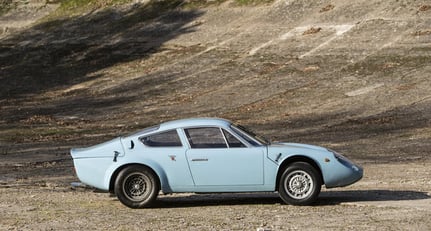Abarth Simca
-
Chassisnummer130S-0091
-
Losnummer7
-
LenkungLenkung links
-
ZustandGebraucht
-
Zahl der Sitze2
-
Standort

-
AußenfarbeSonstige
-
Antrieb2wd
-
KraftstoffPetrol
Beschreibung
From the Maranello Rosso Collection
1963-65 Abarth Simca 'Long-Nose World Champion' Coupe
Coachwork by Beccaris
Registration no. Not registered in the UK
(previously registered in Italy: TO 943339)
Chassis no. 130S-0091
Rumours of a collaborative agreement between Abarth and the French company of Simca began to circulate in 1961. The French company had begun to assemble assorted Fiat models under licence in France, intending to provide the French motoring market with low-price utility cars. Upon Simca's establishment in 1935 a plant producing Fiat 508 Balillas had been set-up at Nanterre, and the Simca Cinq began production the following year, exactly replicating the contemporary Fiat 500. Late in 1961 the Simca company which had been founded by Italian entrepreneur Enrico Teodoro Pigozzi, launched its most successful model the Simca 1000. This was its first rear-engined car and also a neat four-door saloon that became the direct competitor of the contemporary Renault Dauphine. Its chosen power unit was Fiat 600-derived, emerging as a 944cc four-cylinder providing 35bhp in standard form. The Simca 1000 was larger, more roomy, more powerful and faster than the contemporary Fiat 600D, and after its launch at the 1961 Paris Salon its production mushroomed into 1962 to reach 160,000 units for the year.
Carlo Abarth's old Viennese sparring partner, Rudi Hruska, had become a technical consultant with Pigozzi's French venture, and regularly brought Abarth's successes with its Fiat-based cars to the company boss's attention. The powerful promotional platform of competition success reflecting credit upon the source-vehicle manufacturer really appealed and in effect Abarth was then invited to become a test and promotional partner of the French company. Abarth was to produce a Gran Turismo car using Simca 1000 components as its base, and hence the 'Simca Abarth' or 'Abarth Simca' the terms are interchangeable - 1300 emerged.
Carlo Abarth's team designed a completely new engine for the new venture, using the tried and tested broad architecture of the twin-cam 1000 Bialbero -bore and stroke dimensions of 76mm x 71mm to displace 1,288cc, compression ratio cited as 10.4:1 and induction via two large twin-choke Weber 45DCOE carburettors. The twin overhead-camshaft head disposed its two valves per cylinder at an included angle of 80-degrees. The new model's floor pan, transmission, steering and suspension were drawn from Simca 1000 production, while the body matched the latest Fiat Abarth Coupe configuration.
The Simca Abarth 1300 was launched in February 1962 at a list price of Lire 3,300,000. Pending its homologation by the FIA as a Gran Turismo the Simca Abarth 1300s contested the sports category and immediately became dominant within its International category. The model's early victories particularly in hill-climbs persuaded Carlo Abarth to invest in further development of the Simca-based theme. In February 1963 the Geneva Salon saw the Simca Abarth 1600 launched with a completely in-house Abarth 1591cc engine with 68.5mm cylinder bore, five-main bearing crankshaft, and for the first time in Abarth history twin-plug per cylinder ignition sparked by two distributors driven off the forward ends of the overhung rear-mounted power unit. Technical Director Mario Colucci provided the car with an upturned tail extremity to the engine cover, creating a spoiler device far more subtle in appearance than Ferrari's contemporary finest on the 250 GTO.
The Simca Abarth 1300s proved capable of running rings around the rival Alfa Romeo Giulietta during the 1962 season, and the 1600 with 138bhp at 7,800rpm and with Girling disc brakes all round was capable of 240km/h 149mph. These were rocket ships, indeed.
But still there was a further step that the Simca Abarth series would take. Abarth's 1963 racing record included a staggering 535 victories, of which 90 were scored alone by the Simca Abarth 1300s such as this absolutely outstanding example now offered here.
Based on gossip circulating during the closing months of 1961, the media and enthusiast fraternity expected that Abarth would work upon the mechanics of the new rear-engined Simca 1000 saloon model and transform it simply into a sports car. However, the big surprise came in February, 1962, when the press were given a preview of the new Simca Abarth 1300, powered by a new twin-overhead camshaft engine internal code '230' which was clearly inspired in its general configuration by the new 1000 Bialbero (twin-cam) motor of the latest Fiat Abarths. The body design of the new Franco-Italian Gran Turismo Coupe was also influenced by the latest small-capacity GTs styled in-house by Mario Colucci at Abarth's famous Corso Marche factory, and built "just around the corner" there by Odoardo Beccari's specialist carrozzeria.
The new model's wheelbase length of 2090mm also lent itself to a more graceful, better-proportioned and elegant appearance compared to the Fiat 600-based sister GT car's 2000mm length.
Carlo Abarth personally invested considerable resources and enthusiasm in the 1300 Coupe, which according to marque historian Luciano Greggio "...plugged a gap beyond the 1-litre capacity in the range of cars he produced".
With bore and stroke dimensions of 76mm x 71mm, the new 1300's swept volume was listed as 1288cc, standard compression ratio 10.4:1, and with two valves per cylinder the unit breathed through two twin-choke Weber 45DCOE carburettors. It had dry-sump lubrication and a rev limit of 7,200rpm, and its claimed power output was 125bhp at 6,000rpm. With its floor-pan, transmission, steering and suspension all derived from the Simca 1000. Weighing-in at barely 630kg 1,388lbs the new model was capable of 230km/h 142mph. Its list price upon introduction in February 1962 was Lire 3,300,000 and in both International and national competition it instantly became the 1300cc class car to beat...
From the 1300 model grew the 1600 and ultimately the 2000GT model. All shared externally quite similar bodywork and the cars absolutely proliferated most notably in European and American competition during the early-to-mid 1960s.
The car offered here is individually one of the most original, least adulterated and most desirable of all the many Abarth models which graced the magnificent Maranello Rosso Collection's marque-tribute display at Falciano, San Marino, until this past summer. The car has a Conrero tuning and racing team history, and it presents today as if it has only been taken from the race circuit within recent years.
An extensive documentation file accompanies the car, including the original Italian registration authority libretto for its Turin registration, 'TO 943339'. It is listed there as having been registered originally on April 19, 1963, that registration period extending until September 18, 1967, during which period one might suspect it was retained as a factory works team car.
It was then re-registered to SpA Autotecnica Conrero e C. on September 19, 1967, while the libretto also records an ownership change on March 17, 1973, to one Dario Cuppini of Turin. A separate Automobile Club d'Italia 'Foglio Complementare' continuation document has also survived in the file, inferring Conrero ownership from new on May 31, 1963, then transfer to Dario Cuppini in 1973, followed most significantly by sale to Fabrizio Violati's Bellancauto SpA company, of Rome, on May 13, 1978. This makes '0091' as offered here one of the earliest major Abarth models to be acquired for what became Signor Violati's magisterial Maranello Rosso Collection. The car thus survived in enthusiastic Violati ownership for no fewer than 36 years.
Upon technical inspection we can confirm that the engine is free and turns easily, while its cylinder bores are lightly glazed with minor evidence of surface rusting as is to be expected after many years of static museum display. Engine oil in the dry-sump tank is low and accumulation within the engine is suspected. Water hoses and fuel lines are commonly perished, again completely predictable after museum display, and the only substantial problem appears to be a badly corroded coolant-system header tank. The clutch system is currently inoperable, but all gears in the desirable four-speed (as opposed to the less reliable six-speed) gearbox are selectable.
Most notably, the car features almost every one of the myriad fine-tuning special features which one would desire upon such a competition Coupe in period, including addition brake cooling ducts, etc.
Despite its long life as a prime exhibit within the Collezione Maranello Rosso display halls in San Marino and at Falciano, '0091' offered here appears to be in really sound general order.
This outstanding and potentially extremely competitive Simca Abarth 1300 GT has been inspected on BONHAMS' behalf by very experienced marque experts who pronounced themselves "in awe" at its originality and overall presentation-level after so long on static display. We recommend '0091' after its history of only three confirmed owners ex-works - here as being worthy of the closest consideration. Expert inspection and re-commissioning will obviously be necessary before a new owner should consider running it in earnest but this is indeed a jewel of the Collection created and run for so long by the late Fabrizio Violati and his San Marino team.
Please note this vehicle is subject to the reduced import tax of 5% should it remain in the EU.






















